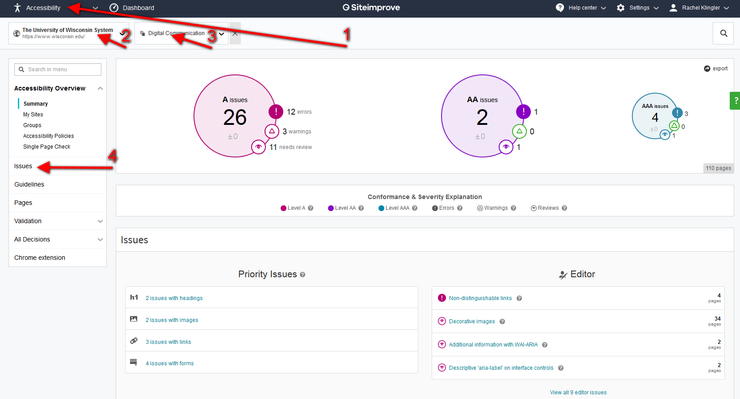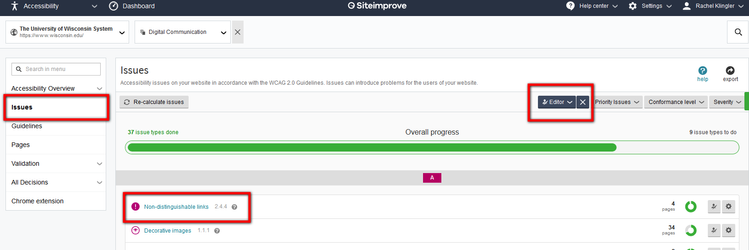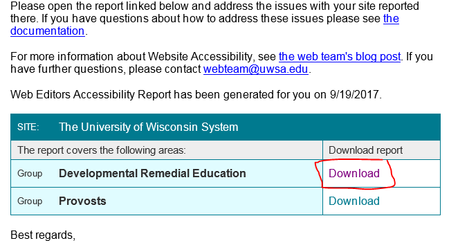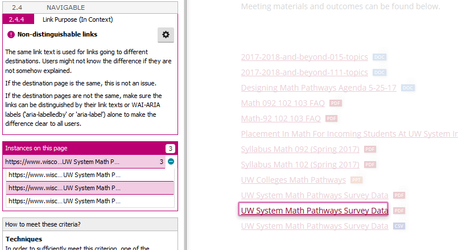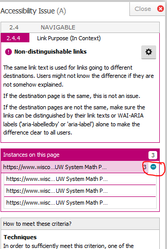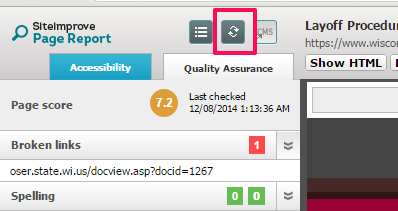Using Site Improve for Accessibility
Site Improve monitors our site for accessibility issues so we can be sure to build a site accessible to all people.
Overview
Log into Site Improve Accessibility to view accessibility information for your site. After you have logged in, you will see an overview page.
Your username is your UWSA email, but the password is not connected to your email password. If you don't remember your password, use the Forgot Password link, and submit your UWSA email address. You will be sent an email with a link to reset your password. If you get a message that no user with that email address exists, contact the web team to get an account set up.
Some highlights on the page:
- Feature toggle: On the top menu, you can toggle between Site Improve features. To view Accessibility issues, choose the Accessibility option.
- Site toggle: Most people will only have access to one site. However, HR and Transfer are their own sites. Use the site toggle to choose the site you are viewing.
- Group toggle: Use the group toggle to choose the community site you would like to view information about. Use this so you only see information for sites you edit.
- The issues menu is the main place to look for information about your site. .
Viewing Issues Online
- After using the group filter to look for only information on your site, use the Issues item on the left hand menu to view the issues that affect your pages.
- Use the "Responsibility" dropdown at the top of that page to filter for only issues with "Editor" responsibility. These are the issues that you need to address.
- For each of the issues with an exclamation point icon next to them (Errors), click on the issue to view the pages affected by that issue.
There will also be issues with triangle and eye icons. These are checks that Site Improve can't determine programmatically, so they will show up any time certain features are used. At first, focus on the Errors. - Click on a page affected by the issues. The place on the page where that issue exists should be highlighted. See below for information on how to fix each error.
Viewing Issues in Email Reports
- For each of your sites, open the report and look for issues without 100% done.
- For each issue, each page with the issue is listed. Click the magnifying glass to see the page report.
- The page report will highlight where on your page the issue exists.
- See below for help fixing issues.
Fixing Errors
Image Issues
All images should have an alt attribute. By default, if you don't add alt text to your image, Zuse will mark it as null, meaning the image is purely decorative. Site editors are responsible for adding descriptive alt text if the image is not purely decorative.
If you do add Alt Text to your image, write a short description of the image. It shouldn't be more than a handful of words.
Images should not include text. Do not include images of text because they can't be interpreted by screen readers. If you include a graph or other image that contains content, make sure that content is also available in another format.
- Image with no Alt attribute: Update the image in Zuse to include alt text.
- If this is a decorative image with this issue (so you don't want to include alt text), you can often get rid of this issue by editing the image, clicking update and updating the page. This resets the image so Zuse can handle it properly. If this doesn't work, please contact the web team.
- If it is images within a Google map or Site Improve reports it cannot refind the issues, you can ignore them.
- Image link has no alternative text: All images that are links need to have non-null alt text. To fix this issue, either add a alternative text to the image or remove the link from the image.
- If an image is in a callout, you will need to edit the image in the Media collection. (Collections > Media)
- To edit an image, click on the image and then choose the pencil icon. Add the alt text in the Image Details popup.
Link Issues
Link text needs to be descriptive and understandable, even out of content. This means using text that describes where the link is going instead of something like "click here."
- Link text not sufficient & Link text is not descriptive: Make sure that the link text describes where the link is going.
- Link refers to a non-existing element: This will be displayed if you have a link to an anchor (starts with a pound sign) that does not exist on your page. You need to either remove the link or add the anchor.
- Link text used for multiple different destinations: If you have links on your page with the same text, they need to go to the same place. If you are seeing this error, you need to update the link text to distinguish between different destinations.
For example: If you have multiple callouts with "Go" as the button text, edit the button text of each of the callouts to be descriptive (for example "View Financial Reports").
Tip: When viewing the issue for the Non-destinguishable links, you can click the plus icon next to the text to see a list of the places where that link text appears.
Heading Issues
Screen readers rely on headings to give site visitors an outline of the content on the page. Using headings properly also makes your page easier to navigate for people of all abilities.
As much as possible, headings should be semantic meaning that they follow a structured layout with the largest heading coming first. Page titles are always level 1, so the first heading in your content should be a level 2.
- Heading is missing text: Empty headings cause problems for screen readers. Make sure you don't have any headings without content. In general, you shouldn't have blank lines in your content. If you need one for some reason, make sure it is just a plain paragraph text line.
- Headings are not properly nested: In the main content of your page, headings should be nested properly. Start with a heading level 2, and work down from there. Don't choose a heading level just based on the look. In some cases your content may be flagged because of headings in sidebars. If that is the case, it may be alright to have this issue. Reach out to the web team.
Use Appropriate HTML
- Avoid using the <bold> and <i> tag: The <bold> and <i> tags are both tags that are outdated and unaccessible to screen readers. Use <em> and <strong> tags instead. Zuse automatically does this, but if you copy and paste text into Zuse you may find you have this issue. To fix this in Zuse, highlight the text that is formatted, remove the formatting using the toolbar and then reformat it.
Issues not caught by Site Improve
- PDFs must be accessible: All PDF documents that you link to from our website must be accessible. This means that they must be made directly from a program like Word and cannot be scanned images.
- Images don’t contain text.
- Videos are captioned or transcripts are available.
- Headers are used appropriately: All pages should use headers when appropriate. Headers should be used semantically, meaning H2 should be the top level header, and smaller headers should be used from there.
Rescanning Site
Site Improve reports on a cached version of our website. By default, Site Improve updates its reports every week. This means that broken links that have been fixed may still show up as broken in Site Improve. If you have been working on your site, you can request that Site Improve rescan your site so that you can see up to date statistics. When looking at the main (summary) Quality Assurance page for your group (please do not kick off a rescan of our whole site), scroll to the bottom in the History section and choose the Re-Check group button. This will not be available if Site Improve is currently doing a whole-site scan. You can also request the scan of an individual page. To do that, while looking at the page report, choose the recheck page button in the header.
Related articles
